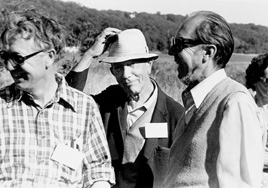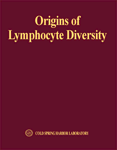|
XLI: Origins of Lymphocyte Diversity 1976 |
|
|

|
From left: Dr. Oliver Smithies, Dr. Felix Haurowitz, Dr. Alain Bussard SYMPOSIUM SYNOPSIS LIST OF PARTICIPANTS CONTENTS OF SYMPOSIUM VOLUME PHOTOGRAPHS PUBLISHED VOLUME  |
Origins of Lymphocyte Diversity
1976
Symposium Synopsis
Organizer: J.D. Watson
Some ten years ago the concept that antibody specificity resided in precise amino acid sequences became generally accepted. Serious thought then began as to whether this meant that a separate germ-line gene would exist for each of the very large number of light and heavy immunoglobulin chains that are used to construct the many thousands of different antibodies that a single vertebrate animal is capable of generating. Though much discussion on this topic occurred during our 1969 Symposium on Antibodies, it was clear then that many new facts had to be obtained before the genetic origin(s) of antibody diversity would be understood.
Over the past few years many of the experimental methodologies necessary to give us these facts have emerged. Nucleic acid hybridization techniques, for example, now provide a direct way to count gene copies. So we thought the time was again ripe for a Symposium to discuss the diversity question and hopefully this time to come up with firm answers—but with the qualification that the answers might not be as simple as we once guessed.
Now the immunological response is no longer regarded as the simple calling into action by antigens of lymphocytes already predetermined for the synthesis of single antibodies. Not only are lymphocytes divisible into the broad B and T categories, but the B-cell response generally requires some form of interaction with the T lymphocyte. For reasons which are still unclear, a diversification of the lymphocytes themselves is necessary for most immunological responses. In this process, key roles are played by immune response genes that are coded by the same gene complex responsible for the major histocompatibility surface antigens.
We thus suspect that we may not understand antibody diversity at a fundamental level until we understand more deeply the underlying cellular processes which generate so many lymphocyte classes, each capable of finely tuned interaction with the others. So we decided to use this Symposium to discuss antibody diversity within the much broader field of lymphocyte diversity. This meant, however, that we would be looking over almost all of immunology, and that we would be bringing together people of widely different objectives and vocabulary. Choosing the right speakers was not simple, and I am much indebted for advice given by Baruj Benacerraf, Gerald Edelman, Herman Eisen, Aurion Mitchison, Martin Raff, and Matthew Scharff. The final program witnessed eighty-seven formal presentations before a total audience of three hundred and twenty-six, most of whom stayed for the entire week.
As in the past, key financial support was provided by the National Institutes of Health, the National Science Foundation, and the United States Energy Research and Development Administration. The very large number of speakers from abroad required still additional sources of funds, and we are most indebted to Merck Sharp and Dohme Research Laboratories and Hoffmann-La Roche, Inc., for their generous responses to our last-minute requests for assistance.
From the start, our able publications staff, headed by Nancy Ford and assisted by Annette Zaninovic and Roberta Salant, knew that all the participants wanted the most speedy publication possible. We have thus aimed for publication within ten months, an almost heroic goal considering the formidable size of this resulting volume.
The bringing together of so many people from so many places was not a simple organizational matter, and we are especially indebted to Dorothy Hesselman, Gladys Kist, Joan Cook, and Thelma Sambrook for the efficient operation of our meetings office. Note should be made of the superb showing of the slides by Paul Kornblueh, Kenneth McElwain and Gayle M. Newman. Hardly one mistake occurred throughout the meeting, a noteworthy performance considering that most evening sessions lasted until near midnight.
— Jan A. Witkowski
Search images: